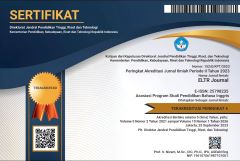DEVELOPING STORIES AS MINDFUL LEARNING MATERIALS FOR INDONESIAN EFL LEARNERS
Abstrak terlihat: 574 / PDF terunduh: 436DOI:
https://doi.org/10.37147/eltr.v7i1.161Keywords:
English grammar, instructional media, mindful teaching, short storyAbstract
In the era where fictional works are popular with teenagers while there are still challenges in understanding English, the researchers conducted a study to develop stories with the title “Berteman itu Sulit”. One of the challenges is the lack of varied learning material in grammar learning. The researchers propose to develop an English material based on the students’ own life context, that is mental health, to make the post-pandemic learning process interesting. The short stories are used as English mindful material with 5 tenses included; simple present tense, present continuous tense, simple past tense, past continuous tense, and present perfect tense. In developing short stories, the researchers went through 4 steps; 1) story development; 2) validation; 3) publication; 4) trying out 10 EFL students from random schools. With a total of 13 parts, the stories are being published on Wattpad platform, the most popular fiction reading site in the post-pandemic era. There are three things to be underlined as the result; 1) the content for grammar material is adequate; 2) the learning material is validated as mindful and suitable for students to read; 3) the try-out questionnaire showed positive results of EFL learners’ perspective to the material.
Downloads
References
Aini, W. N. (2013). Instructional media in teaching English to young learners: A case study in elementary schools in Kuningan. Journal of English and Education, 1(1), 196–205.
Al Harrasi, K. T. S. (2012). Using stories in English Omani curriculum. English Language Teaching, 5(11), 51-59. https://doi.org/10.5539/elt.v5n11p51
Biswas, A., & Anis, M. A. R. (2017). teaching of grammar through short stories. Journal of Science and Technology, 7(1 & 2), 179–190.
Brumfit, C. J., & Carter, R. A. (1986). Literature and language teaching. Oxford: Oxford University Press.
Deller, S., & Price, C. (2007). Teaching other subjects through English. Oxford: Oxford University Press.
Demir, H. (2012). The role of native language in the teaching of the FL grammar. Journal of Education, 1(2), 21–28.
Collie, J., & Slater, S. (1991). Literature in the language classroom: A resource book of ideas and activitie. In Cambridge handbooks for language teachers (5th ed.). Glasgow: Cambridge University Press.
Fonseca, M. D. F. M., & Vasquez, M. E. A. (2007). Difficulties students have in using grammar in the 3th year in the afternoon shift in high school Camino Del Rio (BA thesis). National Autonomous University of Nicaragua (UNAN).
Gall, M., Gall, J., & Borg, W. (2006). Educational research: An introduction (8th ed.). London: Pearson.
Hall, G., & Cook, G. (2012). Own-language use in language teaching and learning. Language Teaching, 45(3), 271–308. https://doi.org/10.1017/s0261444812000067
Kabat-Zinn, J. (2003). Mindfulness-based interventions in context: Past, present, and future. Clinical Psychology: Science and Practice, 10(2), 144–156. https://doi.org/10.1093/clipsy.bpg016
Kahraman, A., & ?entürk, S. (2020). The use of short stories in English language teaching and its benefits on grammar learning. International Journal of Curriculum and Instruction, 12(2), 533–559.
Kidd, L. I., Tusaie, K. R., Morgan, K. I., Preebe, L., & Garrett, M. (2015). Mindful teaching practice: Lessons learned through a hearing voices simulation. Issues in Mental Health Nursing, 36(2), 112–117. https://doi.org/10.3109/01612840.2014.953278
Kilickaya, F. (2004). Authentc materals and cultural content n EFL classrooms. The Internet TESL Journal, 5(7).
Koss, M. D., & Teale, W. H. (2009). What’s happening in YA literature? Trends in books for adolescents. Journal of Adolescen; Adult Literacy, 52(7), 563–572. https://doi.org/10.1598/jaal.52.7.2
Lembaga Penerbit Badan Penelitian dan Pengembangan Kesehatan (LPB). (2018). Laporan Nasional Riskesdas 2018. Kementrian Kesehatan RI. Retrieved from http://repository.bkpk.kemkes.go.id/3514/1/Laporan%20Riskesdas%202018%20Nasional.pdf
Loukia, N. (2006). Teaching young learners through stories: The development of a handy parallel syllabus. The Reading Matrix, 6(1), 25–40.
Maley, A. (2001). Literature in the language classroom. In R. Carter, & D. Nunan (eds.), The Cambridge guide to teaching English to speakers of other languages (pp.180–185). Cambridge: Cambridge University Press.
McCormick, S., & Zutell, J. (2010). Instructing students who have literacy problems (6th ed.). London: Pearson.
Méndez, M. D. C. G., & Pavón, V. V. (2012). Investigating the coexistence of the mother tongue and the foreign language through teacher collaboration in CLIL contexts: perceptions and practice of the teachers involved in the plurilingual programme in Andalusia. International Journal of Bilingual Education and Bilingualism, 15(5), 573–592. https://doi.org/10.1080/13670050.2012.670195
Musthafa, B. (2010). Teaching English to young learners in Indonesia: Essential requirements. Educationist, 4(2), 120-125.
Oktay, Y. B., & Osam, U. V. (2013). Viewing foreign language teachers’ roles through the eyes of teachers and students. Hacettepe Universitesi Egitim Fakultesi Dergisi-hacettepe University Journal of Education, 44(44), 249–261.
Paran, A. (2008). The role of literature in instructed foreign language learning and teaching: An evidence-based survey. Language Teaching, 41(4), 465–496. https://doi.org/10.1017/s026144480800520x
Pardede, P. (2011). Using short stories to teach language skills. JET (Journal of English Teaching), 1(1), 14-27. https://doi.org/10.33541/jet.v1i1.49
Raab, K. (2014). Mindfulness, self-compassion, and empathy among health care professionals: A review of the literature. Journal of Health Care Chaplaincy, 20(3), 95–108. https://doi.org/10.1080/08854726.2014.913876
Rofii, A., Murtadho, F., & Rahmat, A. (2018). Model of contextual-based academic writing learning module. English Review: Journal of English Education, 6(2), 51.
Savvidou, C. (2004). An integrated approach to teaching literature in the EFL classroom. The Internet TESL Journal, 5(12). Retrieved from http://iteslj.org/Techniques/Savvidou-Literature.html
Si, J. (2018). English as a native language, World Englishes and English as a lingua franca-informed materials: Acceptance, perceptions and attitudes of Chinese English learners. Asian Englishes, 21(2), 190–206. https://doi.org/10.1080/13488678.2018.1544700
Souisa, T. R., & Yanuarius, L. (2020). Teachers’ strategies on teaching grammar: Facts and expectations of senior high school teachers at Ambon. International Journal of Evaluation and Research in Education (IJERE), 9(4), 1121-1127. https://doi.org/10.11591/ijere.v9i4.20643
Wajnryb, R. (2003). Stories narrative activities in the language classroom. Cambridge: Cambridge University Press.
Downloads
Published
How to Cite
Issue
Section
License
Copyright (c) 2022 Aldila Ihsania Mufidah, Irene Nany Kusumawardani

This work is licensed under a Creative Commons Attribution-ShareAlike 4.0 International License.













